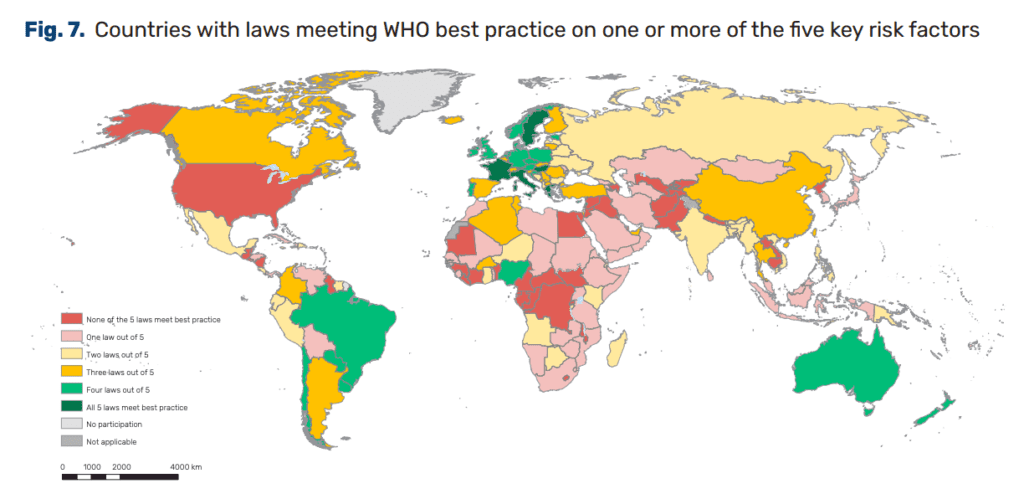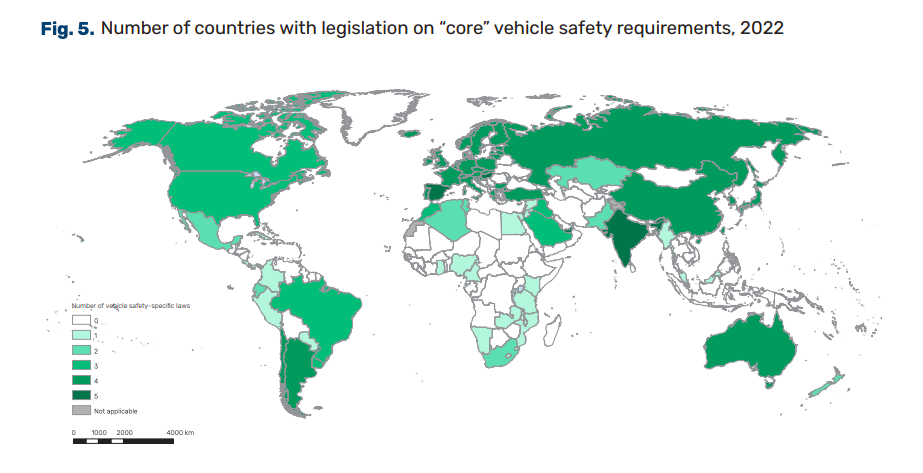Overview
The Global status report on road safety 2023 details the scale of global road traffic deaths, and progress in advancing laws, strategies and actions to reduce them around the world. The fifth report in a series, it provides an overview of progress between 2010 and 2021, and sets a baseline for the United Nations Decade of Action for Road Safety 2021-2030 target of halving road traffic deaths and injuries by 2030.
The Global status report on road safety 2023 shows that the number of annual road traffic deaths has fallen slightly to 1.19 million. The report shows that efforts to improve road safety are having an impact, and that significant reductions in road traffic deaths can be made if proven measures are applied. Despite this, the price paid for mobility remains too high. Road traffic injuries remain the leading killer of children and young people aged 5-29 years. More than half of fatalities occur among pedestrians, cyclists and motorcyclists, in particular those living in low and middle-income countries. Urgent action is needed if the global goal of at least halving road traffic deaths and injuries by the year 2030 is to be achieved.
Facts
- Road traffic deaths and injuries remain a major global health and development challenge.
- As of 2019, road traffic crashes are the leading killer of children and youth aged 5 to 29 years and are the 12th leading cause of death when all ages are considered.
- Two-thirds of deaths occur among people of working age (18–59 years), causing huge health, social and economic harm throughout society.
- More than half of fatalities are among pedestrians, motorcyclists and cyclists. Occupants of 4-wheel vehicles account for almost one-third of fatalities.
- Occupants of vehicles carrying more than 10 people, heavy goods vehicles and “other” users constitute one-fifth of all deaths. Micro-mobility modes such as e-scooters account for 3% of deaths.
- Vulnerable road users such as pedestrians, cyclists and motorcyclists remain dangerously exposed. Nearly 80% of all roads assessed do not meet a minimum 3-star rating for pedestrian safety, and as cyclist fatalities increase, just 0.2% of all roads assessed have cycle lanes.
- Nine in 10 deaths occur in low- and middleincome countries, while people in low-income countries continue to face the highest risk of death per population.
- Globally, 28% of all fatalities occur in the WHO South-East Asia Region, 25% in the Western Pacific Region, 19% in the African Region, 12% in the Region of the Americas, 11% in the Eastern Mediterranean Region, and 5% in the European Region.
- The European Region reports the largest drop in deaths since 2010 – a 36% decline. The Western Pacific Region reports a 16% decline, the South-East Asia Region a 2% decline and the number of deaths has remained constant in the Region of the Americas. Reductions in the number of deaths were observed in 108 countries, including 10 where the 50% was achieved by 2021.
- Ten countries reduced the number of deaths by 50% and another 35 countries reduced deaths by 30–49% between 2010 and 2021.
- The South-East Asia Region has the highest death rates and numbers overall.
Call for better standards and policies
The report reveals an alarming lack of progress in advancing laws and safety standards. Just six countries have laws that meet WHO best practice for all risk factors (speeding, drink–driving, and use of motorcycle helmets, seatbelts and child restraints) while 140 countries (two-thirds of UN Member States) have such laws for at least one of these risk factors. Of note, 23 of these countries modified their laws to meet WHO best practice since the Global status report on road safety 2018.
The global motor-vehicle fleet is set to double by 2030. Yet just 35 countries – less than a fifth of UN Member States – legislate on all key vehicle safety features (e.g. advanced braking systems, front- and side-impact protection, etc). The report also reveals major gaps in ensuring safe road infrastructure, with just 51 countries – a quarter of UN Member States – having laws that require safety inspections that cover all road users.
Countries with laws meeting WHO best practice on one or more of the five key risk factors


Read more: Download: Global status report on road safety 2023
- Political declaration of the fourth high-level meeting of the General Assembly on the prevention and control of NCDs and the promotion of mental health and well-being
- Kathmandu Declaration: Financing for Universal Health Coverage
- The Belém Health Action Plan for the Adaptation of the Health Sector to Climate Change
- Registration Now Open: Delivering for Nutrition in South Asia 2025 – Towards Impact at Scale!
- World Chronic Obstructive Lung Disease (COPD) Day 2025: Short of Breath, Think COPD!


